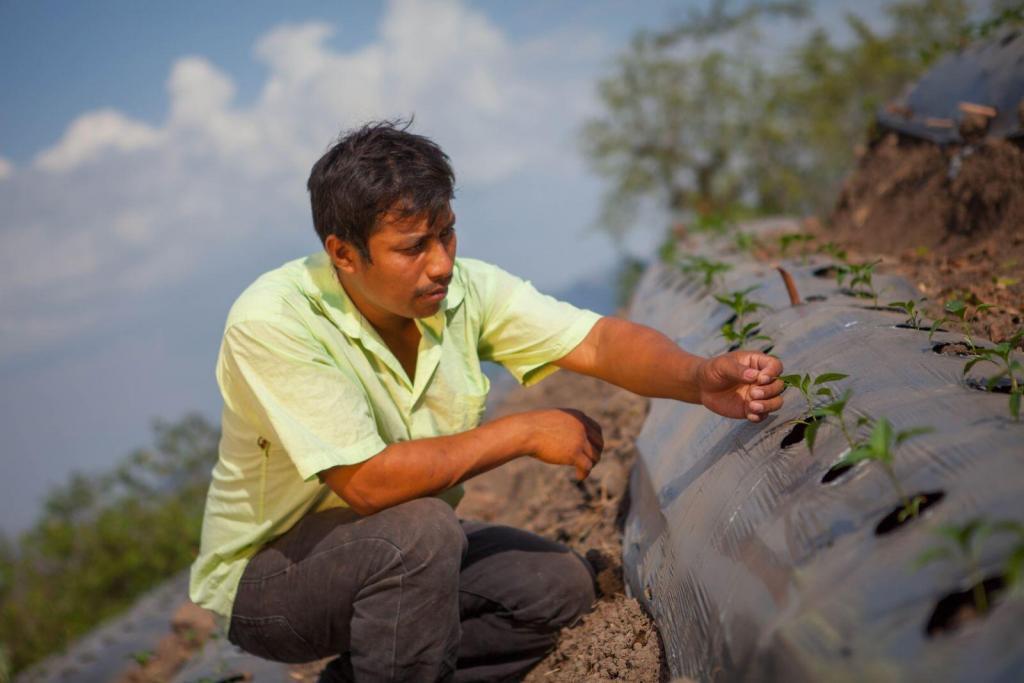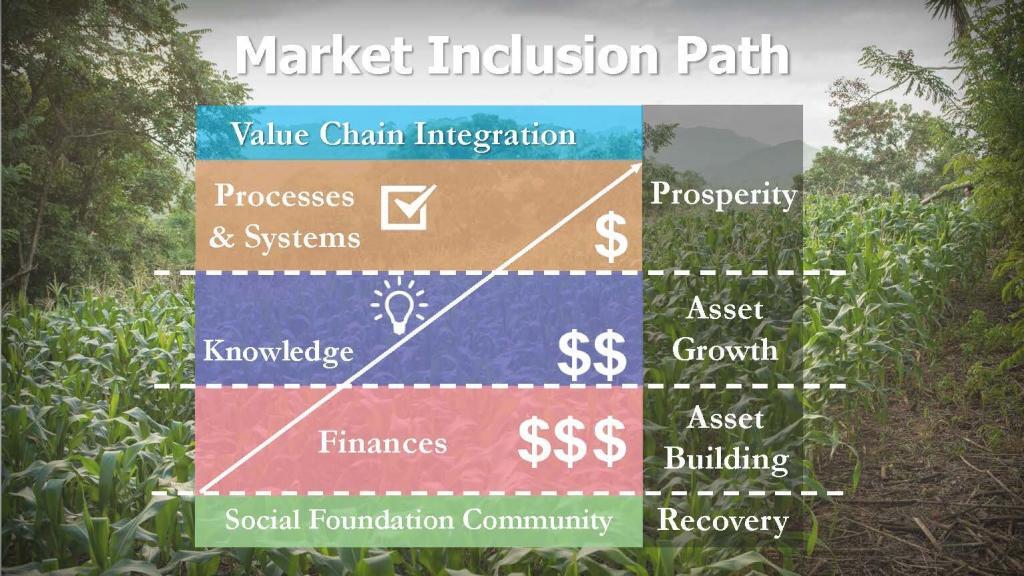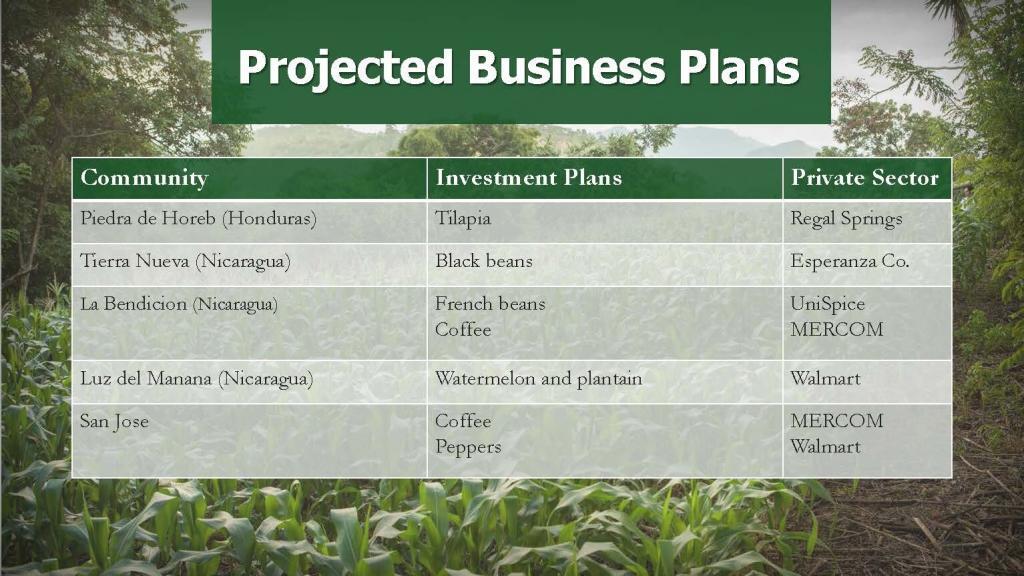DIRECT FROM THE FIELD: JANUARY 2016
By Carly Boyden and Anna Lehn
On January 15 we hosted a fascinating Direct from the Field webinar discussion between Executive Director Alberto Solano and Magdalena Wallhoff, Global Sales and Social Investment Director at Regal Springs Tilapia. They talked about building a pathway to sustainable prosperity for small, rural farmers like ours.
We want to share highlights here. Magdalena and Alberto discussed a strategy that builds on our powerful holistic model to connect families with what we now believe to be the key to long-term prosperity: sizable, international markets for our farmers’ produce, so their families can generate consistent, sufficient income.
WHAT DOES PROSPERITY MEAN?
For a small Nicaraguan farmer or anyone else in the world, prosperity is the same. It’s a matter of consistent, sufficient income.
Consistent, sufficient income means you’re no longer dependant on others. It allows you to be flexible – adapting to your family’s expenses for children and business development – and resilient – bending instead of breaking under medical emergencies or crop losses.
For the small farmers targeted by Agros, true prosperity is a herculean goal. It goes beyond the basic requirements of life, like clean water and food. Prosperity requires you to develop your farm into a profitable business. For that, you need the capital, technology and knowledge to invest in producing consistent, high value crops with a market in place for your products. You need someone who’ll buy them for a fair price so you recoup your investment plus a profit.
Importantly, for many Agros families, developing a consistent income stream from farming is the only way they can stick together. Men in rural families are often forced to migrate for long portions of the year, following the harvests or traveling to Costa Rica, where the economy, buoyed by tourism, offers reliable employment for laborers.
HASN’T PROSPERITY ALWAYS BEEN THE GOAL FOR OUR FAMILIES?
Yes, and for the last 30 years we’ve built an incredibly strong foundation to achieve this goal. Reaching prosperity from a position of extreme poverty is complicated.
The chart below shows our Theory of Change, the pathway we’ve envisioned to help families move from poverty into recovery – where we focus on supplying basic needs – and then onward toward prosperity – where our focus shifts to business development.

Let’s take a look at a few sections of this chart:
The left vertical axis moves from vulnerability to resilience. This shows a family’s ability to resist shocks. The vulnerability-resilience axis reminds us that early gains in any effort to lift families out of poverty are not guaranteed to last. Stability is fragile when you have no safety net. Injuries, price swings, external conflicts, even the birth of a child, can cause a family who’s living in a relative security to suddenly sell off possessions or move. The further families progress along the axis toward resilience, the more assured their gains will be.
The right vertical axis moves from farming for personal consumption to farming for income. You’ll see that this axis is titled market performance. Market connections make farming profitable. And profitable farms produce steady income. Connecting to markets is the only way families can achieve resilience, which parallels permanent market sales.
Family progress follows an S-curve. Initially after families move into Agros communities, their progress swells. The difference between squatting in a shack with four bodies sleeping in one bed, and living in an organized community with a home and clean water tap, is immense. As we begin to address secondary and tertiary needs around education, community organization, and business development, progress becomes iterative. Results aren’t as dramatic or as quick.
The later stages of growth and prosperity, however, are where we have the opportunity to make a family’s escape from poverty permanent. At first glance, the return on investment in later stages may seem reduced. You might ask why it’s worthwhile to invest so much to move families all the way to prosperity when there are so many desperately impoverished families. At Agros, we believe long-term investment is worthwhile when you want long-term results. A stabilized family who still occasionally migrates for work is much more likely to fall back into poverty than a family whose profitable farming business has cemented them into prosperity. We want our families to close the door on poverty for good.
HERE’S A MORE DETAILED LOOK AT OUR PLAN OF WORK WITH FAMILIES AT EACH STAGE:

But we don’t work with families in isolation. At Agros, we build villages in partnership with families because we believe healthy communities increase the resilience of every family within. On the community level, we work to construct a platform of services, infrastructure, social systems, and social capital that lifts up every family, no matter what the family’s individual progress toward prosperity.
Each of these four focus areas increases a family’s odds of long-term economic success: centralized water cholorination protects families from water-borne illnesses; trained healthcare volunteers, or brigadistas, offer healthcare oversight to pregnant women and new mothers far from urban hospitals; roads allow farmers to transport their produce safely to markets; and community-led governance builds families’ abilities to lead and self-advocate.

HAVE ANY OF OUR FAMILIES OR COMMUNITIES REACHED PROSPERITY?
Yes. Norlan, for example, a pepper farmer in San Jose, Nicaragua, invested several years ago in growing high-value peppers. With careful and rigorous cultivation of these fragile plants, he recouped a profit of $2,300 his first year, enough for a payment toward his land loan, a cushion for emergency expenses and a small pool of capital to reinvest in next year’s crop.

Another example is in Piedra de Horeb, Honduras, where a group of well-organized farmers have created a registered and profitable LLC. They cultivate and supply in-demand tilapia to markets that guarantee a steady income.
In short, individual farmers have succeeded, developing integrated small businesses that produce high quality crops for ready markets. But we haven’t been able to consistently replicate this model across all of our communities. Why?
The path to prosperity is long and complex. After establishing a basic sense of security, individuals like Norlan and the Piedra fish farmers had to develop a small pool of capital, then gain knowledge about market demands and technical farming methods, and finally create systems to manage their farming businesses.
This process is an enormous undertaking for someone who was recently a subsistence farmer, and it requires a major psychological adjustment from the mentality of day-to-day survival to the efficiency and adaptability of an agri-businessperson. Only our most determined and entrepreneurial individual farmers have made it to prosperity thus far.
HOW CAN WE HELP EVERY FAMILY REACH PROSPERITY?
We believe we can systematically help our families get to prosperity by helping them achieve “value chain integration.”
In the business of agriculture, “value chain” is special jargon referring to the series of exchanges and profits made bringing produce from a farmer’s field to a consumer’s table. For Agros farmers to make a profit from their farms, they need to be integrated into that value chain, so that they’re cultivating a crop that’s demanded by consumers. This is even more complicated because we’re talking about perishable, easily damaged products: food.
Our farmers need to produce the right crops, at a competitive quality and scale, and harvest and transport them, unblemished, to market. This requires, as we mentioned before, cash in hand to invest, knowledge of markets and crops, and the development of processes to systematize a farm business just to reach the point where farmers are ready to integrate.

HOW DO WE INTEGRATE OUR FARMERS INTO THIS VALUE CHAIN?
Two elements have to come together: private sector partnerships and market-ready farmers. Let’s dig in with an explanation of what we mean:
1. Private sector partnerships: Simply put, we need to step in and help connect our farmers to major, international markets. The best our farmers can do at present is attempt contracts with small, local produce buyers. But our Executive Director Alberto has developed an extensive network of connections with huge agricultural exporters like Walmart over his 15 year agricultural development career, prior to joining us last fall.
Over the past few months, he has leveraged our credibility and his agricultural connections to find private sector partners ready to contract with Agros farmers.
In a “forward purchasing contract,” a private sector partner, like Walmart, will actually finance an entire crop, providing seeds, technology and sometimes training in exchange for our cooperation with their quality standards and deadlines. At harvest time, they’ll purchase the finished produce at a range of pre-set prices that vary based on quality.
For a small farmer, private sector partnerships are transformational. They provide not only markets, but also upfront capital and technology. It’s a package deal that gives farmers the tools they need to produce a crop consumers want.
On the private sector side, there are benefits to working with small farmers as well. Small farmers provide geographic diversity, which alleviates the risk of crop loss to natural disasters and disease. There’s also another set of reasons the private sector is drawn to work with small farmers related to the economics of development. Poverty is destabilizing, and private companies don’t want to suffer losses at the hands of conflict or upheavals. By investing in small farmers, they invest in a stable ecosystem for business. Conversely, when impoverished families gain a reliable source of income, they’re no longer just eating what they can grow and become potential customers for those same agricultural companies.
Ultimately, partnering with small farmers is simply good business when the farmers can transact with the private sector as professionals. That brings us to the other side of the equation – what do our farmers need to do to meet the private sector at the table?
2. Market-ready farmers: Once a farmer has a supply of capital, knowledge, and systems and processes in place, they’re ready to meet the private sector’s standards. At this point they can be counted on to produce:
- A reliable supply of goods. Our farmers need to prove that they can be counted on to deliver their product on time, every time.
- Consistent quality. This means the farmers must meet a specific set of standards for each crop cycle in size, shape, and quality.
- Crops to meet shifting demands. Private sector companies don’t want a single crop farmer. Our farmers must be able to adapt to shifts in demand from beans to coffee to passion fruit. Farmers who are not flexible will be left behind.
Now, for a small farmer, especially one who’s had no training or resources, this level of business acumen is not easy to achieve. It’s not possible for a farmer who’s weak from illness and literally trying to keep his family alive.
Market readiness depends on the work we’ve always done. Clean water. Preventive healthcare. Food security and community organization. Our holistic model builds a foundation of health, security, and social organization in villages that stabilizes families so they’re confidently able to transact with the private sector with professionalism and efficiency.
DO WE HAVE PARTNERSHIPS FOR OUR VILLAGES READY FOR 2016?
Yes! For each of our six active communities, Alberto has identified partners ready to invest in crop cycles with our farmers. With the support of our agricultural staff, we’re creating two-year business plans for each village that will provide year-round income for families. Here’s a sample of the partners and crops we’ve planned for each community:

HOW MUCH WILL THESE PLANS COST? WHAT’S THE RETURN ON INVESTMENT?
We are ready to launch the investment cycle in our first round of business plans for six communities. The private sector is ready to provide seeds, technology and training for our farmers, but Agros must provide seed capital and cover implementation expense to guarantee these contracts.
We’re finalizing investment proposals for each community’s business plan to share with you. These proposals provide a complete overview of:
- crop cycle plans
- full budgets including implementation expenses, capital investment by Agros and the private sector, overhead, and expected returns
- projected income for each farmer in years one, two, and beyond
- projected land loan repayments collected as a result of farmer income
By positioning our primary support for each village as a business investment, we expect to recoup capital expenses, which will recycle into a permanent Investment Fund. This fund will provide a revolving source of investment dollars that will leverage gifts like yours to spread seeds of prosperity in new communities year after year, all the while gradually reducing our dependence on charitable support.
Farmers will also benefit from a land loan repayment that’s built into their contracts. The rate of land loan repayment has varied in our communities due to a host of factors – income levels; culture of repayment; and alignment of loan amounts with family size and ability to pay. By building repayments into contracts, we’re offering families the same opportunities we have to automatically deduct loan payments or retirement contributions from our paychecks. The land loans we offer are by far the largest loan families have ever received, so it’s our responsibility to develop systems of repayment that are achievable for families.
HOW CAN I GET INVOLVED?
We’d love to set up a meeting to discuss these plans with you. Please contact us at 206.528.1066 or email donor.services@agros.org.
Have questions or thoughts? Ask or respond in the comments, and we’ll get right back to you.
 Anna Lehn
Anna Lehn
Marketing & Communications Manager



